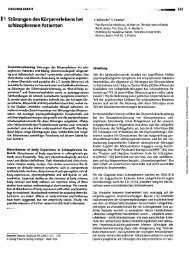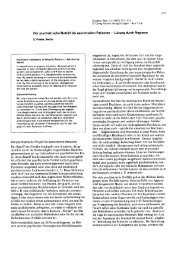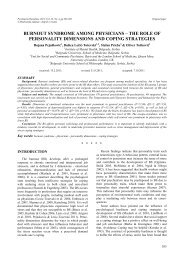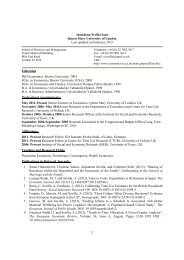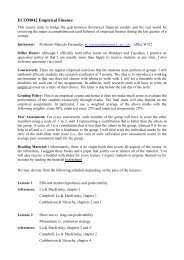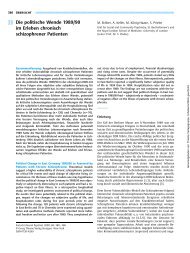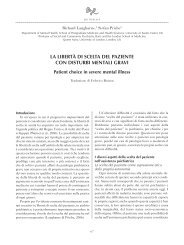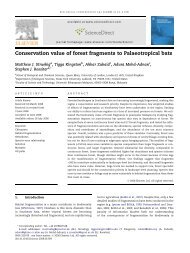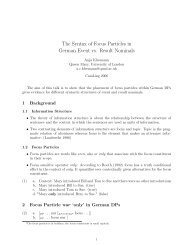Proofs - Personal Webspace for QMUL - Queen Mary, University of ...
Proofs - Personal Webspace for QMUL - Queen Mary, University of ...
Proofs - Personal Webspace for QMUL - Queen Mary, University of ...
Create successful ePaper yourself
Turn your PDF publications into a flip-book with our unique Google optimized e-Paper software.
S42 A. Heinz et al. / European Psychiatry 27 (2012) / supplement n°2 / S32-S43<br />
two self- construal styles: People who endorse individualistic<br />
values think <strong>of</strong> people as independent <strong>of</strong> each other and describe<br />
themselves using stable personality traits. This is refl ected in<br />
a preference <strong>for</strong> general self- descriptions, e.g., “I am honest”.<br />
By contrast, subjects who endorse collectivistic values think <strong>of</strong><br />
people as highly interconnected to one another and describe<br />
themselves as embedded in specifi c social contexts. This is<br />
refl ected in a preference <strong>for</strong> contextual self- descriptions, e.g.,<br />
“When talking to my mother, I am honest”. During fMRI, Japanese<br />
and European American study participants were presented with<br />
general and contextual self- descriptions. Brain responses were<br />
measured in the medial prefrontal cortex, a core area <strong>of</strong> the cortical<br />
midline structures associated with self- referential processing.<br />
The authors report that agreement with individualistic cultural<br />
values was associated with greater medial prefrontal activation<br />
during general self- descriptions. In contrast, agreement<br />
with collectivistic values resulted in greater medial prefrontal<br />
activations during contextual self- descriptions [8]. These<br />
effects <strong>of</strong> self- construal styles were observed across cultures,<br />
i.e., among Japanese as well as among European American study<br />
participants, supporting the hypothesis that individualistic and<br />
collectivistic values are present within different cultures. The<br />
authors conclude that self- referential processing in the medial<br />
prefrontal cortex varies as a function <strong>of</strong> self- construal style.<br />
11. The social per<strong>for</strong>mative<br />
and narrative construction <strong>of</strong> identity<br />
Cultural constructions <strong>of</strong> identity infl uence not only the self<br />
concepts <strong>of</strong> individual persons but also <strong>of</strong> social groups and<br />
classes. This can be illustrated looking at the Rastafarian religion.<br />
How can it be explained that Jamaicans started around 1930 to<br />
venerate Ras (i.e. Duke) Tafari, the Ethiopian heir to the thrown,<br />
who is better known by his crown name Haile Selassie I., and<br />
based a religious movement on this veneration? In his book<br />
“Rasta and resistance”, Campbell turned to the social confl icts in<br />
Jamaica to explain this religious movement [4]. In the 1930ies,<br />
Jamaica was a colony <strong>of</strong> Great Britain, and each class room<br />
was decorated with the respective picture <strong>of</strong> the ruling British<br />
king or queen. Africa, on the other hand, was described both<br />
in the colonial discourse and in the view <strong>of</strong> the upper classes<br />
as a “primitive” place, devoid <strong>of</strong> history. Such prejudices were<br />
challenged when pictures <strong>of</strong> an African king appeared in the<br />
news, who was the heir to the thrown <strong>of</strong> an ancient African<br />
civilisation. Black nationalists in Harlem, in other cities in the<br />
United States and in Jamaica used this picture to promote selfconsciousness<br />
among African Americans. In Jamaica, Howell<br />
and Hinds suggested that Jamaicans could only show loyalty to<br />
one king and that this king is not the British monarch but Haile<br />
Selassie I. Both were imprisoned, however, the new movement<br />
was not successfully suppressed. The Rastafarian movement<br />
early on started to identify with the anti- colonial struggles in<br />
Africa. The movement further gained momentum after fascist<br />
Italian troops invaded Ethiopia, when pictures <strong>of</strong> Ethiopians<br />
resisting this invasion and <strong>of</strong> Haile Selassie I. appeared in the<br />
news. One <strong>of</strong> the signs <strong>of</strong> the Rastafarian movement, the long<br />
uncombed hair, was originally shown by the anti- colonial “Land<br />
and Freedom Army” (Mau Mau) in Kenya, where it was worn<br />
to demonstrate a “natural” African hair dress, which resisted<br />
Western concepts <strong>of</strong> artifi cally straightened hair [4]. Social<br />
identity was thus <strong>for</strong>med using symbols <strong>of</strong> successful resistance<br />
against colonial rule. Of course most Africans who were abducted<br />
to America came from West Africa and not from Ethiopia [41].<br />
However, historical exactness is not the goal <strong>of</strong> such a social<br />
construction; instead, the Rastafarian movement used symbols<br />
and practices which represented the dignity and successful fi ght<br />
<strong>for</strong> equal human rights and used them against the devaluation<br />
<strong>of</strong> African traditions in the colonial situation.<br />
What goes on in such movements can be explained with<br />
Turner´s concept <strong>of</strong> per<strong>for</strong>mance: The anthropologist Turner<br />
suggested that also in less antagonistic societies than in colonies,<br />
group confl icts can arise, which are represented and refl ected<br />
in social drama [65]. Turner used the example <strong>of</strong> the Brazilian<br />
“Umbanda” cult, a religion that intentionally integrates African<br />
elements, which are supposed to represent “pure nature” in<br />
opposition to the threatening urban reality. During the per<strong>for</strong>mance<br />
<strong>of</strong> these rituals, social confl icts among the participants are<br />
refl ected in the roles acquired by the participants. Thus put into<br />
scene, the per<strong>for</strong>mance <strong>of</strong> the social drama can heal the violated<br />
social order and support the individual identity that is threatened<br />
in its impoverished urban environment. The supposedly<br />
“natural” African and Native American traditions are used in a<br />
syncretistic way, which links catholic saints, spirits derived from<br />
native American traditions and African gods (“Orishas”) <strong>of</strong> the<br />
West African Yoruba. The Umbanda cult and the organisations<br />
supporting these per<strong>for</strong>mances thus constitute a parallel society,<br />
which supports oppressed classes and groups by providing a<br />
place in an imaginary hierarchy, which strengthens their identity<br />
via the ritualised expression <strong>of</strong> their confl icts, emotions and<br />
social status within this cult [60]. The decisive element <strong>of</strong> such<br />
a ritual is thus not the historically correct and “authentic” use<br />
<strong>of</strong> African traditions but the self- conscious identifi cation with<br />
the African heritage, which is otherwise quite too <strong>of</strong>ten not<br />
appreciated and respected – also in the post- colonial discourse.<br />
<strong>Pro<strong>of</strong>s</strong><br />
12. Summary and outlook<br />
These considerations show that the “self” is a fl uid concept;<br />
rather than resembling a rock which stands fi rmly in the sea<br />
<strong>of</strong> events, perceptions and emotions, the “self” is socially<br />
constructed and articulated around experiences which appear<br />
to be shared by all human beings. Such universal experiences<br />
appear to include the prerefl ective access to individual thoughts<br />
and feelings, an automatic knowledge that (at least in non-<br />
pathological states) these emotions and cognitions belong to my<br />
self. Conscious self- refl ection, on the other hand, is necessarily<br />
imbued with social and cultural norms, narratives, images and<br />
events, <strong>of</strong>ten <strong>of</strong> confl icting nature, and the social and individual<br />
struggles underlying such self- images can <strong>of</strong>ten be identifi ed and<br />
understood. To do so, it is not decisive to possess complex lexical<br />
knowledge about each culture and its history; instead, each<br />
individual synthesis has to be respectfully approached, so that<br />
we can try to understand how a person constructs the personal<br />
image <strong>of</strong> his or her self by using available parts and pieces <strong>of</strong><br />
the respective cultural, social and autobiographic experience<br />
and tradition.




